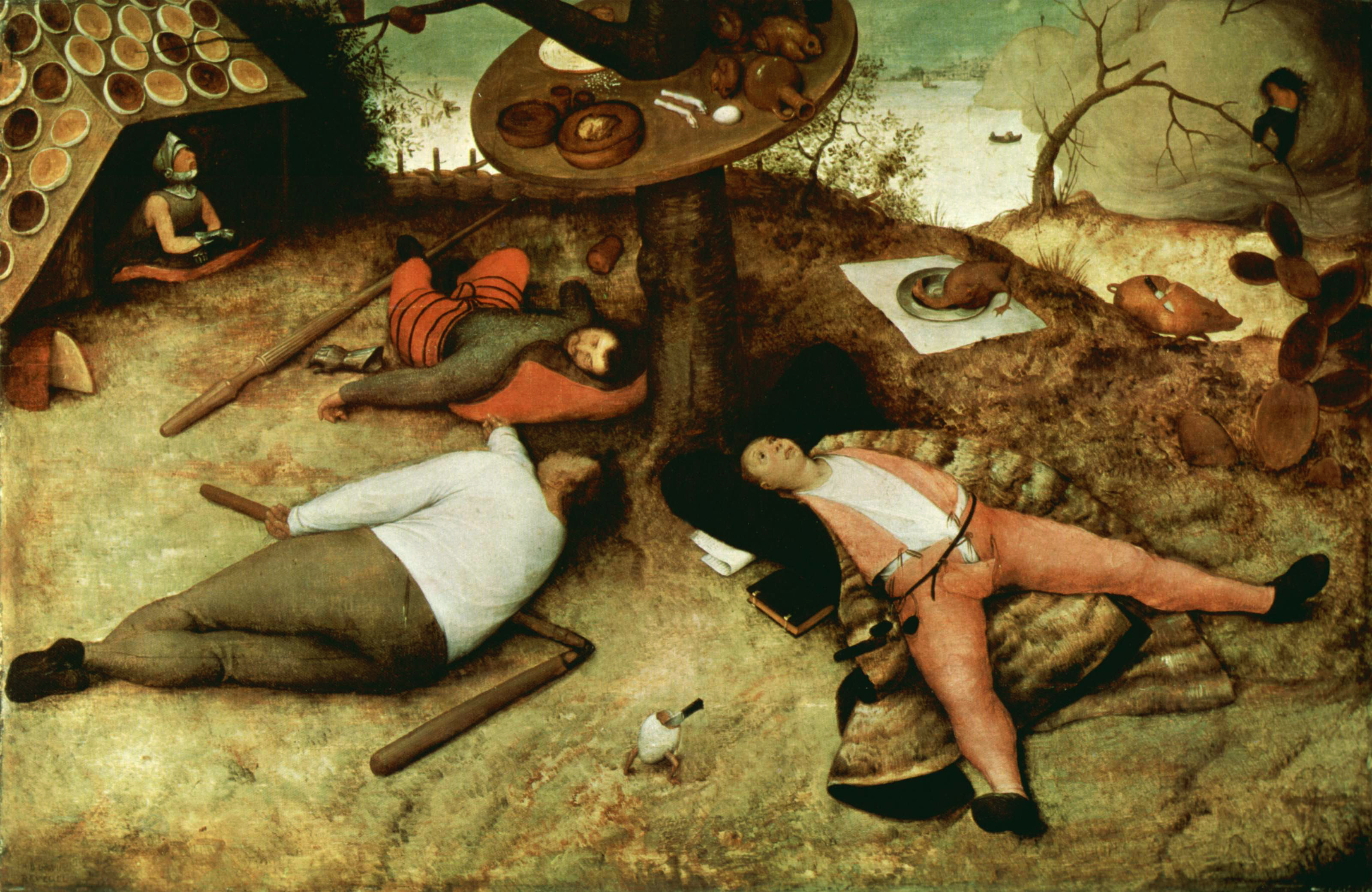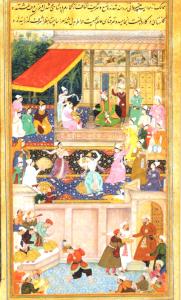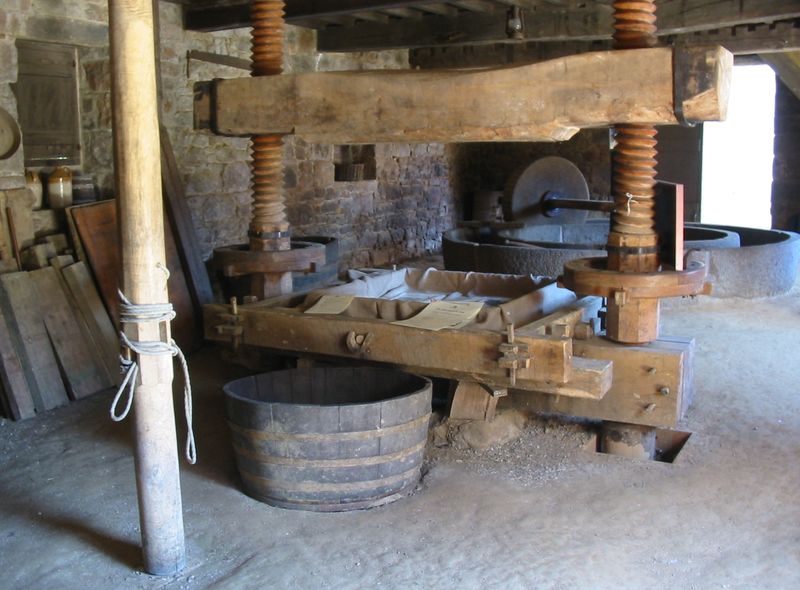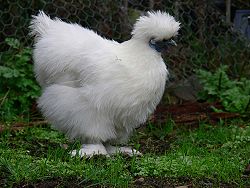So this thing happened. The thing where you get curious “Why” something isn’t allowed. Like say pork for Middle Eastern cooking. I mean pork is tasty tasty meat…who doesn’t love pork? Right?! So I went down a rabbit hole, then Pennsic then Steppes Artisan. Here is the research present on Pork.
The Tale of a Piggy in Period
By
Honorable Lady Sosha Lyon’s O’Rourke
The Tale of a Piggy in Period
Pig has a special place, whether good or bad, for medieval cooks and gastronomics. This edible mammal has undergone changes from a favored food for the rich to a food associated with the poor or undesirable. When I first started researching pigs, I did so because I find pork tasty; very tasty! However, I do a lot of Middle Eastern cooking, which has no pork. I have always been curious as to why. Pork is incredibly tasty and seems to be readily available to both rich and poor. The research was illuminating in many ways on both how the pig developed and why some people find pork to be unclean, and therefore inedible.
Pig /pig/ noun:
1a) a young domesticated swine not yet sexually mature; broadly: a wild or domestic swine b) an animal related to or resembling the pig.
2a) pork b) the dressed carcass of a young swine weighing less than 130 lbs
3) dirty, gluttonous, or repulsive person
(http://www.merriam-webster.com/dictionary/pig)
This evolving little piggy:
Starting from the beginning, pigs evolved into one of the fastest breeding meat animals, with a digestion that can handle almost anything. pig evolution started as a two-toed mammal. Most of these two toed mammals went on to become grass eaters, i.e. cows, goats, and sheep. Grass eaters require many heavy grinding teeth to chew down grass. Think cows chewing cud. They also require multi-chambered stomachs in which to break down cellulose. allowing bacteria in their gut to provide enough nutrition. Pigs’ digestions is unusual in that it is very similar to humans’ digestion with one stomach and similar teeth. They are omnivores, which means they can eat anything remotely edible.
Pigs evolved from wild to domesticated over several hundred to thousands of years. Normally, pigs in the wild would eat nuts, roots, grains and anything that didn’t move away fast enough like grubs, or dead animals. This is called mast fed. Pigs became attracted to human habitation because humans would throw inedible bits away into middens (trash heaps) where dogs and pigs would forage. The more pigs got used to feeding on human garbage the “tamer” they became, no longer having to forage for their food 100% of the time. (Essig)
This also simplifies a more in-depth look at several genetic considerations such as flight vs. fight adaptations. Those pigs, like dogs, with lower flight and fight genes stayed closer to humans instead of avoiding them. We’re going to let that sleeping dog lie for this paper.
Pig reproduction is comparable to that of rabbits; fast and furious, with lots of offspring. They can have up to 12 piglets per litter, twice a year. That’s up to 24 piglets a year, with roughly half of females will be ready to breed in roughly a year’s time. It is estimated that with 1 sow, in 6 years there would be over 2 million pigs. (Hawaii.edu) With this type of math, soon you’re swimming in swine.
In comparison, cows can have up to one or two calves per year. Same for sheep or goats. Rabbits breed quickly but there isn’t a lot of meat on those tiny bones: 1-3lbs for rabbit, as compared to the 180-300 pound porker led to slaughter. A young male swine can reach up to 200 pounds in six months kept in a pen. If mast fed, the weight is lower at six months, taking a year plus to reach such a hefty weight. Now that’s a lot of pork, especially if you have ways to store the meat and fat for more than a week or two. Leave the sows to breed more piglets and you have a very quick growing, mobile and easily fed source of meat. For people who were at the whim of the season or game, having a tame or nearly tame source of readily available meat was the difference between surviving and thriving.
Looking at the other domestic animals with only one or two offspring a year, you might wonder why these mammals were held in such high regard while the pig was sidelined. The other domesticated animals had things counting in their favor. Cows, goats and sheep provide milk and wool besides skin and meat. Plus, being herbivores they were easier to transport when all food to be foraged was grass. Pigs required feed at the end of a traveling day, which was roughly ten miles. Pigs also were not good with being in bright sun, burning easily, unlike herbivores which could be herded through hot sunny days due to their fur.
This hungry little piggy:
Mast feeding continued as long as there were forests surrounding villages (usually small). People would open the pens and herd the pigs to the forests then herd them back to their pens during the day.
A picture of a pig herder in an oak grove, feeding his pigs with both fallen acorns and throwing a stick into the trees to loosen another round of acorns for his charges. (Metmuseum)

http://blog.metmuseum.org/cloistersgardens/2009/11/13/pigs-and-pannage/03v_012r-november_top_full/
Foraging pigs expend 33% of their calories on just finding food. The hope and desire was that pigs would only spend a 3:1 ratio for food-to-meat ratio instead of the original 10:1 that was common until today’s commercial farming. (Carlton)
The closer the connection to humans, the more distinctive the pigs’ domesticated characteristics became. Wild boards have long thin legs, leaner bodies with longer snouts and pointier heads. Domesticated pigs, even those that interbreed with wild boar, retain the juvenile head form, rounder head and shorter snout. (Essig)
From the Luttrell Psalter, showing the 14th century spotted pig of England has many traits as that of a wild boar.
https://www.jstor.org/stable/pdf/23050648.pdf?seq=1#page_scan_tab_contents
This form is so distinctive that archaeologists can determine with a glance at a pig’s head bones, dug up from any midden in any age, whether the pig was wild or domesticated. The shape of the bones at almost any given age at the time of slaughter is telling in shape and size. A domesticated pig’s head is smaller thinner, without the need to root for grubs under rocks or dead trees. A wild boar’s head is wider and thicker suited to act like a plow for foraging hard to get to foods. (theydiffer.com)
As humans stayed closer to home to farm and did less hunting, the pig became a useful domesticated food source, becoming a status symbol as found in Neolithic burials. (Carleton) Pigs would eat the slop, then forage during the day in woods for roots and acorns. Unfortunately, this very resourceful self-sufficiency kept the European pig from reaching a preferred body type; fat. Not to say that boars weren’t heavy, they just weren’t marbled with the pork fat that we’ve come to like in our modern pork chops. Sows would go into heat while in the woods and it was male pigs’ chance to get a ride. Domesticated or wild male, the sow did not care which. (Essig)
Fat wasn’t an undesired trait; but a necessity. Pigs were an excellent source for acquiring fat. The problem though, was that pigs who were mast fed wandered in the woods during the day where little control could be exerted on sows in heat. Any pig would do, including wild boars. Fat could be used not just as a food source but as a food preserving source. This meant that it wasn’t until the 1800s that pigs had standardized types of breeds in Europe. Pig breeding was a wishful dream for farmers who wanted a fatter more marbled meat. The Roman Empire and China were exceptions to this. (Carlton)
This fat little piggy:
The Roman Empire had two types of pigs; the normal mast fed opportunistic type of pig that was considered tasty with long legs and a narrow body

http://www.sophialambert.com/PORK-HAM-AND-BACON.htm
and a second heavier meatier fatter pig that was white with short legs and round body with heavily marbled meat.

https://en.wikipedia.org/wiki/Suovetaurilia
Note the rounded shoulders and heavy jowls of the pig in the lower right portion. This pig was the product of selective breeding and happy feeding. No opportunistic boars need apply for the stud job on this farm!
There were a few in Rome who commented on the desirable qualities for pig and how to feed them.
Columella advised “Not to rely on acorn foraging alone but to make use of legumes for fattening as well. He also advised breeding for a new type of pig more suitable for rapid weight gain than for ranging in the woods. “Pigs should be sought whose bodies are exceedingly wide, but squarish rather than long or round, with protruding belly and large rump rather than tall legs or hooves, a broad glandulous neck, and a short upturned snout.” (Carlton)
However when the Roman Empire fell, this pig type was lost as farms were thrown into chaos. The mast fed pigs from feral stock could outrun the hungry wolf or human while the shorter fatter pig, not so much. Remember it’s not that a pig has to be the fastest just faster than the slowest…and the slowest were always eaten.
China, with its very mountainous terrain, had to eke out the most farming from the worst terrain, and learned early how to keep pigs close and pick the best pigs for breeding. They, like the Romans, liked short legged, round bellied, with lots of fat.
The European pigs started to show what we consider more desirable traits once pigs were introduced via ships from China to Europe and interbreeding could begin. This introduction happened sometime in the 1700s, so what we consider a heritage breed is at best 300 years (roughly) old. (Carleton)
A picture of a Chinese pig by Thomas Bewick
nvhis.oxfordjournals.org/content/16/1/94/F4.expansion.html
While pigs that we consider “heritage” are really post period, the heritage pigs fulfill several niches worth mentioning. One of the more outstanding heritage breeds was called a Lard pig.
. 
http://www.puremangalitsa.org/products.html
The Lard pig, was just what the name implied. A pig guaranteed so round and fat while still mobile enough to walk to market. With this type of pig available, any house wife could buy enough fresh lard for her home cooking needs along with some excellently marbled cuts of meat for dinner or sausage preparation.
Worth mentioning is that much of the machinery pre-WWII was oiled with rendered pig fat aka (lard). Machinery oil replaced lard in the mid-20th century. (https://en.wikipedia.org/wiki/Lard) Until this point, all lubrication was animal fat, pig fat being the easiest to render, ship and buy. (Essig)
This poor little piggy:
Pigs got the short stick on favor ability once villages became cities. Pigs had to be driven, like cows or sheep, to market. Besides needing to be fed every 10 miles, pigs had an ornery habit of running back towards their home stys at the slightest provocation. One account at the start of a pig drive, which could reach up to 10,000 pigs, was to sew the eyes of a pig shut. I’m not really sure I could personally do that. However there is a post period account of how Abe Lincoln did just this as a lad driving his herd of pigs to market. (http://www.atlasobscura.com) Cows and sheep could be driven to a market, grazing their way there. Less hassle then sewing and unsewing pigs’ eyes shut.
I have not found further in period how pigs were driven to market. I can make assumptions such as piglets being taken in baskets. Small, cute, easily transportable this way. Perhaps a full grown pig had rope tied to it’s neck and either tugged along or bribed with food to follow. Possibly even driven to market as noted on the Appalachian trails. The pig drive idea had to come from somewhere, yes?
Because pigs weren’t herded as easily as other meat animals, when taxes were assessed (in period) and payment was needed in the form of meat, other animals were requested. One noted taxation of animals is when the pyramid of Giza was built the Pharaoh asked for X cows, sheep or goats along with X amount of men. Beef, sheep and goat bones were found in the middens (trash pits) for the workers and manager types for the pyramid workers. Archaeologists have studied the buildings for workers, very straight streets and sturdy huts where the better-off managers and workers lived. As the men stayed and married upwards or moved upward in the chain of command these meats became preferred as what the rich people ate.
Next to this “upper” city a looser collection of less well to do section was uncovered. This village was determined to be for hangers-on, composed loosely of winding paths and not very sturdy huts. Archaeologists found mostly pig bones in the middens of the shanty village that catered to the baser desires of the workers to blow a week’s wage on beer and prostitutes. Here it is assumed that the managers and upwardly mobile workers developed a taste for beef, mutton and goat, equating these meats with better living while the poor consumed pork. (Essig)
The Egyptians went so far as to depict Horus judging souls. Where bad souls were turned into pigs.

https://blog.longreads.com/2015/10/14/i-would-rather-be-herods-pig-the-history-of-a-taboo/
Another example of how pork became associated with the poor relates to how easily pork could be stored in salt or fat, much easier than beef or mutton. The taste of salted pork seemed to be better than that of salted beef or mutton.
For shipping and storage, pork was layered with salt in barrels. These barrels would be sold at a very minimal pricing. This is where the term “Scraping the bottom of the barrel” comes from as those who bought the barrel knew they were in dire need of new food when they had to scrape what was left at the bottom to feed their family. (Essig)
Pigs were plentiful. There was plenty of pork to go around, keeping the price within a somewhat reasonable reach for those who weren’t wealthy. Beef, on the other hand, required refrigeration or to be sold on a day to day basis. This extra work raised the pricing of beef and out of the pricing for most poor people. A butcher shop that offered beef had to know his clientele was well-off enough to pay the higher price. The same was true for sheep and goat. The meat from these animals could be salted but was better fresh. Fresh required shops that carried ice or had cold counters for specialty meat were usually located in affluent areas, not the poor. (Essig)
Pork was so plentiful that eating pork became associated with gluttony. Paintings, in period, that wish to allegorically show gluttony would depict people eating pork or with a pig and/or pig parts somewhere in the painting. These portraits were usually of peasants, passed out around the bones or partially eaten remains of a pig, reinforcing the idea that only the poor would eat so much to the ruination of their health and lifestyle.

http://zannifoodcuriosities.blogspot.com/2016/07/food-in-art-history.html?view=flipcard
Pieter Bruegel “The Land of Cockaigne”. Here eating to excess is the deadly sin of gluttony. Note the pig in the upper right? As well as pork snout and portions on the table? The peasants passed out under the table? Gluttony was a peasant thing, nobles should never be so crass as to eat so much and pass out.
This unclean little piggy:
Once towns became bigger, different eating habits became the norm, where pigs were the walking trash collectors. People in towns would dump out food waste into the streets, where the pigs would root around, a mobile cleaning service keeping the pigs well fed without the necessity of a sty for those living in yardless homes or apartment hovels.
However pigs had a taste for any trash including the very undesirable such as eating human waste and dead animals; both of these things were plentiful in medieval towns. Pigs were also notorious for eating small unattended children, or severely biting them. They also had a habit of eating human corpses or just attacking when agitated.
Several lawsuits were charged against pigs. Such as in 1379 when two French pig herders were killed by their charges. The pigs who had done the killing and those pigs that had watched were put on trial. The watching pigs were pardoned while the killing pigs were killed. (www.wired)
Another lawsuit against pigs was in 1494 when a pig was arrested for strangling and chewing on the face of a babe in the cradle, while the parents were out. The judged ruled against the pig, who was strangled by hanging. (www.medievalist.net)
However not everyone raising pigs thought the eating of human feces a bad thing. In the Far East, small outhouses were built up and over the family’s pig pen. Human garbage and waste elimination turned into food.

https://commons.wikimedia.org/wiki/File:Anhui_Fuyang_Han_Dynasty_Pig_Toilet.jpeg
The feeding habit of eating human flesh was not overlooked. This strongly influenced both Judaism and Muslims for refusing an easily raised meat source with horrible eating habits. I have not found direct quotes for this reason; only pigs returning to wallow and unclean because it does not chew cud. (biblehub.com)
It is my belief that prior to towns growing so large and farms cutting down grazing lands that were the normal feeding areas for pigs, that pigs had been in good standing in Europe and the Middle East. However once farms took away the woodlands, and towns needed more wood for fires and grains to feed the populace did the more undesirable traits become so obvious, knocking this mobile meat conversion mammal down a few pegs for eating.
The main trait that endeared the pig to humans, cleaning up the rotting and nasty from around huts, became the trait that would eventually do the pig in.
This edible little piggy:
What I learned from researching why pigs were so much in demand and so reviled, was eye opening. We’ve all heard the jokes about never trust a man with a pig farm or why piglets aren’t in those cutsie petting zoos for kids. Pigs like meat as much as humans do, dead or alive. I didn’t know they would eat feces, though I did know that the slop they were fed (from reading Little House on the Prairie) was something I wouldn’t touch with a ten foot pole. I remember how my own father raised chickens, doing everything wrong according to the books, yet we still had eggs and chickens when I was growing up. I think that’s sort of how pigs were raised once the forests were no longer available for free feeding. The attitude of “Eh, survive so we can eat you later.” instead of finding a humane way of feeding and penning a potentially dangerous but edible animal.
Once we started to consume pigs, because they were easy to raise and tasty, nothing kept the pig from being used in quantity and completely. Everything was used, nothing was wasted. Everyone loved the prime pieces in sauce. Fat and intestines for casing random tidbits of meat and spices; A soft cutable meat product, called head cheese, for the tender cooked parts on the face; Ears, tail and feet were used to make gelatin or eaten in their own right. Organ meats were eaten with gusto as delicacies. There are recipes for the good cuts, the one that modern palates have grown accustomed to, and recipes for the cuts modern palates aren’t used to eating.
My three main sources for cooking are: The Opera of Bartolomeo Scappi, Take a Thousand Eggs by Renfrow, and Apicius. (Italian, English, and Roman). These are by no means the only cook books which have pork recipes. I could fill an arena with all the pork dishes listed and still run out of room; however these are just a few of the books I had on hand. The recipes vary from only excellent cuts of meat (i.e Renfrow) to what the modern palate would consider offal (i.e. Apicius) to everything from nose to tail (Scappi).
So let’s get to the good stuff, we’ve all been waiting for! How to eat all the parts of a pig.
Roman:
Ius in Aprum Elixum: Sauce for Boiled Boar
Krea Tareikhera: Pork in a Red Wine and Fennel Sauce
Minutal Ex Praecoquis: Pork and Apricots Friccasee
Cracklin’ & Pig Skin
English:
Chawettys: Pork and Blue Cheese Pies
Trotters
Pumpes: Pork Meatballs
Bacon
Italian:
Head Cheese
Roasted Pig Head w/Garlic Sauce
Rolled Sow Belly
Resources:
Apicius: Cookery and Dining in Imperial Rome. Translation by Vehling, J., Dover Publications, Inc. New York.
Essig, M., (2015). Lesser Beasts- A Snout-to-Tail-History of the humble pig. Basic Books.
Renfrow. C., (1991). Take a Thousand Eggs. Volume II. 2nd Edition.
The Opera of Bartolomeo Scappi (1570). Translation by Scully. T., (2008). The Lorenzo Da Ponte Italian Library.
http://biblehub.com/deuteronomy/14-8.htm
https://blog.longreads.com/2015/10/14/i-would-rather-be-herods-pig-the-history-of-a-taboo/
http://blog.metmuseum.org/cloistersgardens/2009/11/13/pigs-and-pannage/03v_012r-november_top_full/
http://carleton.ca/linr/wp-content/uploads/Reading-for-Environment-and-History-White.pdf
https://commons.wikimedia.org/wiki/File:Anhui_Fuyang_Han_Dynasty_Pig_Toilet.jpeg
https://en.wikipedia.org/wiki/Lard
https://en.wikipedia.org/wiki/Silphium
https://en.wikipedia.org/wiki/Suovetaurilia
http://hg.ccsd.ws/webpages/ndiamente/index.cfm?subpage=1641894
nvhis.oxfordjournals.org/content/16/1/94/F4.expansion.html
http://theydiffer.com/difference-between-hog-pig-and-boar/
http://www2.hawaii.edu/~halina/201/pigb.pdf
http://www.ancientworldalive.com/#!Ancient-meals-and-eating-habits-Part-2-Romans/c16ee/555085d40cf248741723ecb3
http://www.atlasobscura.com/articles/the-great-appalachian-hog-drives
https://www.jstor.org/stable/pdf/23050648.pdf?seq=1#page_scan_tab_contents
http://www.medievalists.net/2013/09/08/medieval-animal-trials/
http://www.merriam-webster.com/dictionary/pig
http://www.puremangalitsa.org/products.html






































































































Recent Comments